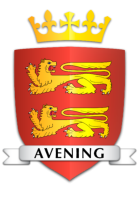

© Avening Parish Council 2023
“Preserve, Conserve, Enhance”
34 Frederick Townsend
Private: 2nd Battalion Devonshire Regiment The second phase of the Germans' last "Big Push" was their Operation "Hagen", aimed at pushing the Allies back to Paris. It was launched in May 1918. This resulted in the Third Battle of the Aisne, in which the 2nd Battalion of the Devonshire Regiment was employed. The battalion was decimated and from a starting strength of over 500 men, it was reduced in a few days to just 47. These were withdrawn and a reinforcement programme started. The new men came from raw recruits straight in from basic training, men of different regiments returning from recovery from wounds and men of other much depleted battalions surviving from the German offensive. It is into this environment that Fred Townsend was posted in June 1918. Having been born on Tetbury Hill in 1900, he was conscripted in the early months of 1918 and, having completed his basic training, was shipped to the 2nd Battalion, Devonshires in June. The mixture of new recruits and old hands trained together for some weeks and, by August, were ready for front line service. The end of that month found them in the trenches in Northern France, at Ploegsteert, (what the British "Tommy" called "Plug Street"), and although not involved in any major battles, there were steady losses during their stay at the front. The battalion war diaries give us a snapshot of their activities throughout September 1918. On the 6th, they were relieved by the 2nd Battalion Yorkshire West Ridings and the following day proceeded to the divisional baths. The next few days were spent relaxing, with a voluntary church service on the 9th and football matches over the next three days. The battalion then relieved the 2nd West Ridings on the 12th and this proved a quiet time on the front. They were there until the 18th, when again, they were replaced by the 2nd West Ridings. The next few days were spent in training and sport activities with football and rugby matches taking place almost daily. A concert was held on the 21st. They returned to the trenches three days later and the men were involved in patrols most nights. The war diary for the 26th of September reads thus: "In the trenches. The Brigade Major and a Royal Engineer officer went out and patrolled bridges over the River Lys. Special Company, Royal Engineers fired Gas Bombs on enemy trenches. Casualties: 2 killed and four wounded ". Fred Townsend was one of those killed that night. He was an unmarried man of 18. The other man killed at the same time was Private John Adams of Rochdale. He was 33 and had been in France since 1915. They are buried, side by side, at Bois-Carré British Cemetery at Thélus. Fred received two medals for his service, which would have been passed to his father, James Townsend, in 1922. By this time the family had moved to Nags Head. Fred was survived by six siblings, three elder brothers, two elder sisters and a brother two years his junior. His mother had died in 1909 but James lived on until 1947. Both were buried in our churchyard, but in unmarked graves. I am indebted to Stephen and Kate Townsend for their assistance.
AveningArchive
WW1 Heroes





© Avening Parish Council 2023
AveningArchive
WW1 Heroes
34 Frederick Townsend
Private: 2nd Battalion Devonshire Regiment The second phase of the Germans' last "Big Push" was their Operation "Hagen", aimed at pushing the Allies back to Paris. It was launched in May 1918. This resulted in the Third Battle of the Aisne, in which the 2nd Battalion of the Devonshire Regiment was employed. The battalion was decimated and from a starting strength of over 500 men, it was reduced in a few days to just 47. These were withdrawn and a reinforcement programme started. The new men came from raw recruits straight in from basic training, men of different regiments returning from recovery from wounds and men of other much depleted battalions surviving from the German offensive. It is into this environment that Fred Townsend was posted in June 1918. Having been born on Tetbury Hill in 1900, he was conscripted in the early months of 1918 and, having completed his basic training, was shipped to the 2nd Battalion, Devonshires in June. The mixture of new recruits and old hands trained together for some weeks and, by August, were ready for front line service. The end of that month found them in the trenches in Northern France, at Ploegsteert, (what the British "Tommy" called "Plug Street"), and although not involved in any major battles, there were steady losses during their stay at the front. The battalion war diaries give us a snapshot of their activities throughout September 1918. On the 6th, they were relieved by the 2nd Battalion Yorkshire West Ridings and the following day proceeded to the divisional baths. The next few days were spent relaxing, with a voluntary church service on the 9th and football matches over the next three days. The battalion then relieved the 2nd West Ridings on the 12th and this proved a quiet time on the front. They were there until the 18th, when again, they were replaced by the 2nd West Ridings. The next few days were spent in training and sport activities with football and rugby matches taking place almost daily. A concert was held on the 21st. They returned to the trenches three days later and the men were involved in patrols most nights. The war diary for the 26th of September reads thus: "In the trenches. The Brigade Major and a Royal Engineer officer went out and patrolled bridges over the River Lys. Special Company, Royal Engineers fired Gas Bombs on enemy trenches. Casualties: 2 killed and four wounded ". Fred Townsend was one of those killed that night. He was an unmarried man of 18. The other man killed at the same time was Private John Adams of Rochdale. He was 33 and had been in France since 1915. They are buried, side by side, at Bois-Carré British Cemetery at Thélus. Fred received two medals for his service, which would have been passed to his father, James Townsend, in 1922. By this time the family had moved to Nags Head. Fred was survived by six siblings, three elder brothers, two elder sisters and a brother two years his junior. His mother had died in 1909 but James lived on until 1947. Both were buried in our churchyard, but in unmarked graves. I am indebted to Stephen and Kate Townsend for their assistance.


























